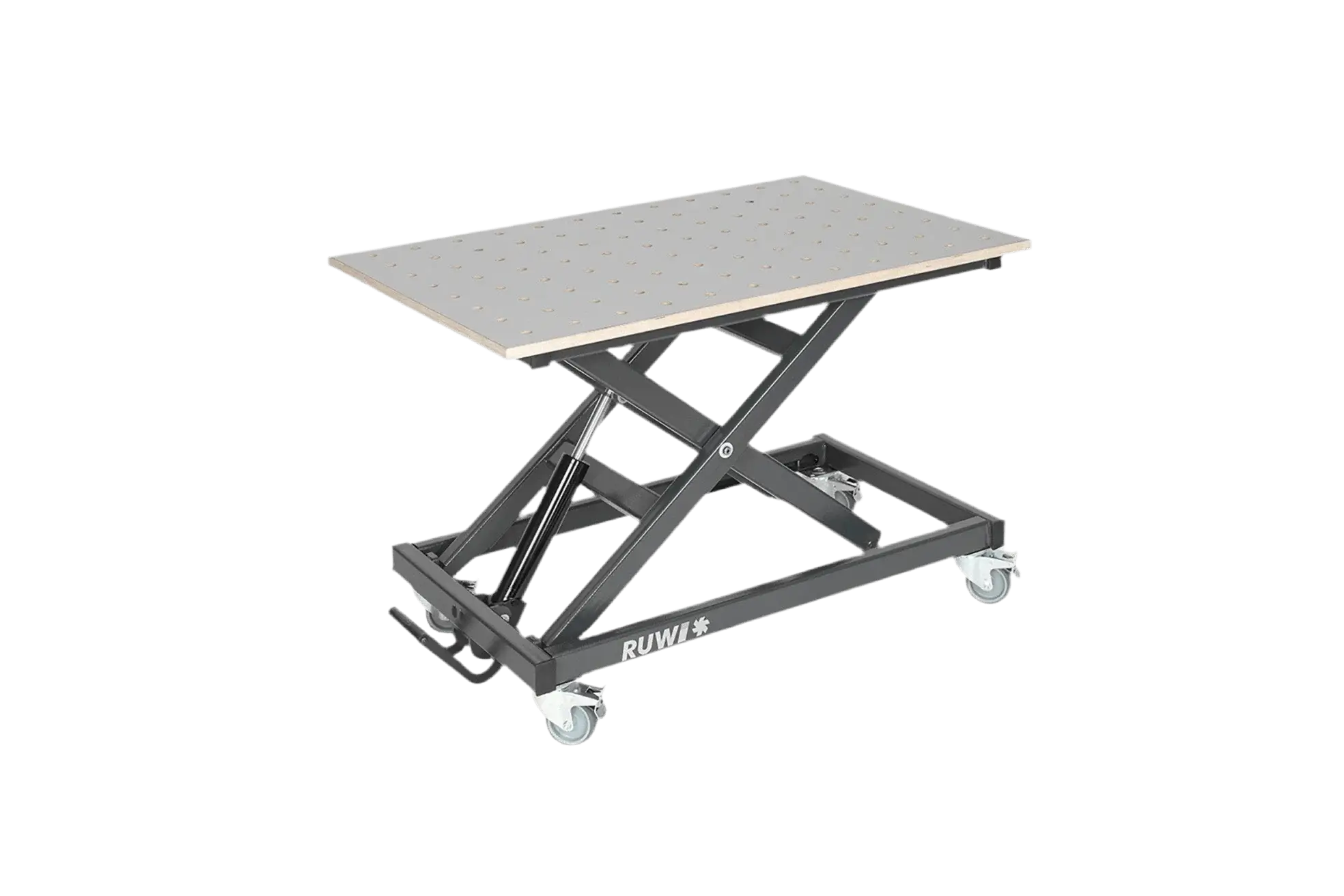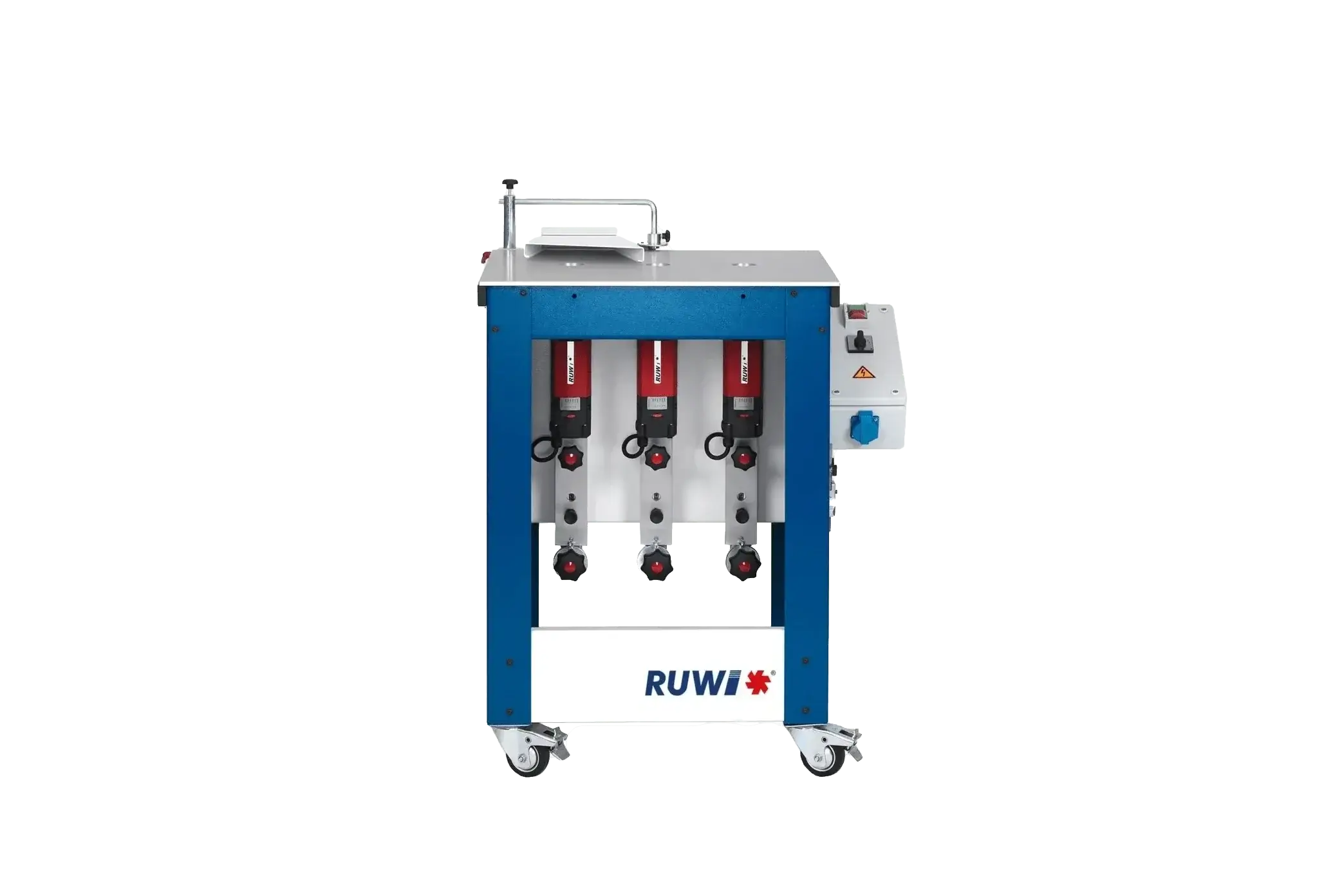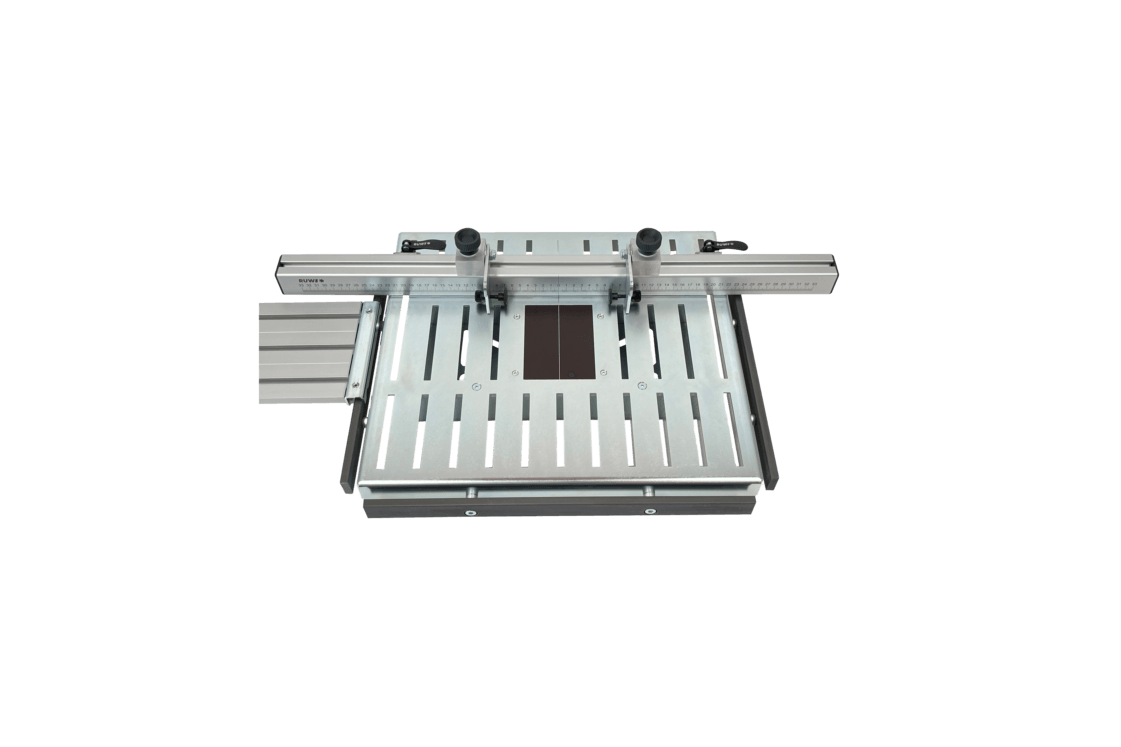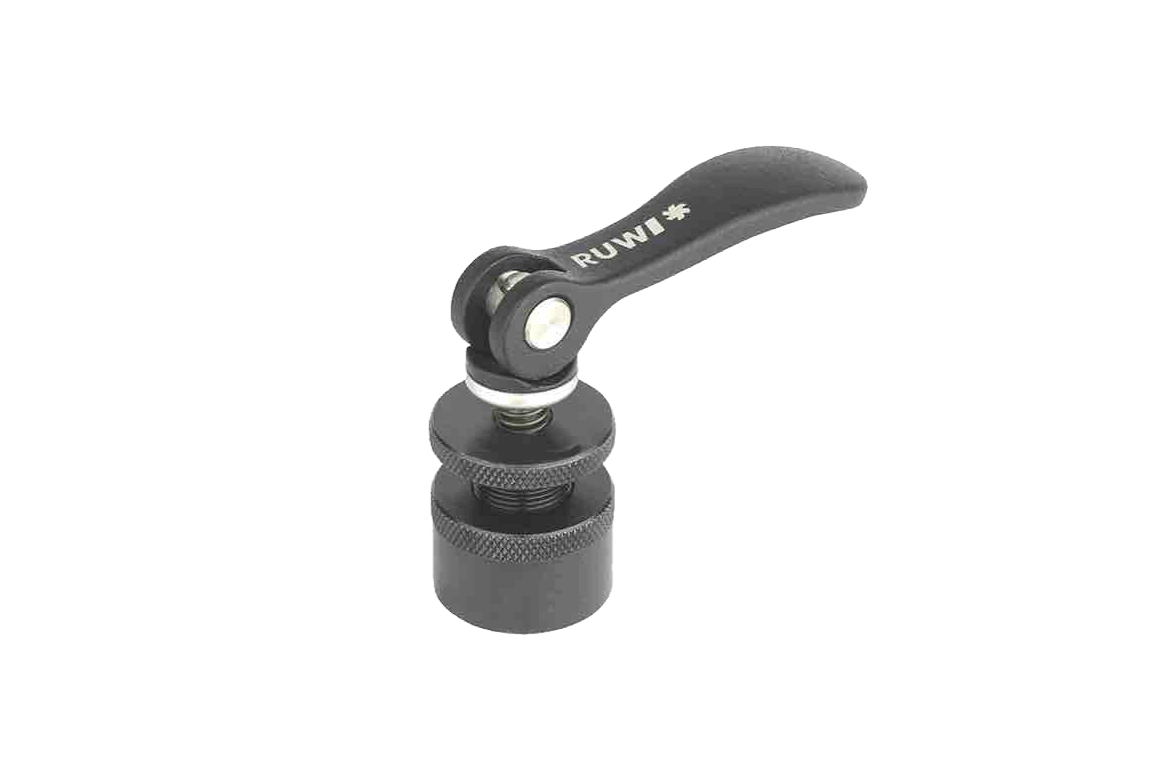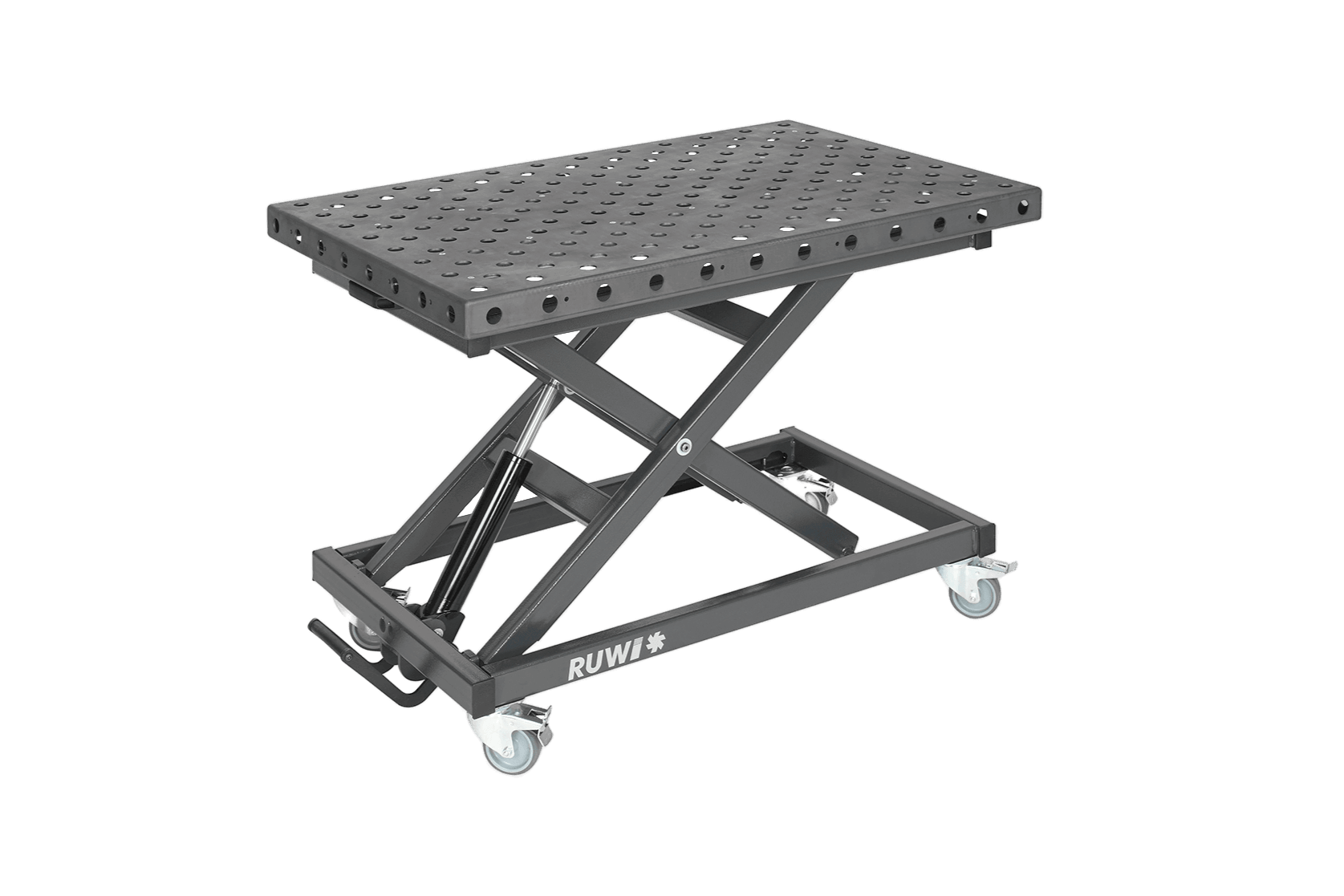Drill a hole in wood
A precise hole in wood is the result of three things: the right tool, the right speed and clean guidance. These instructions show you step by step how to drill safely and without tearing - from marking to finishing.
Table of contents
What is meant by the term drilling?
Drilling is a machining process in which a rotating drill bit is inserted into a workpiece to create holes. Drilling is a fundamental skill for DIY enthusiasts and professionals in the woodworking trade.
Drilling wood: How to choose the right drill
If you want to drill a hole in wood professionally, you need the right drill. When choosing a drill, also consider the type of wood you want to work on. Hardwoods such as oak or beech often require more powerful machines with good torque control to overcome the resistance of the material.
Less powerful machines are usually sufficient for softwoods such as spruce or pine. For panel materials such as MDF or chipboard, a clean cut is important to avoid fraying. Look for a machine with adjustable speed to find the optimum speed for the material and drill diameter.
The right machine not only ensures clean holes without tear-outs, but also enables efficient and safe working. Whether you want to drill on the move with a battery or powerfully with mains operation or prefer a stationary solution for precise series work - choosing the right model is crucial for optimum results.
Drill types
Hand drill with mains connection
A hand drill with mains connection offers reliable performance for continuous work. It is ideal for drilling holes in wood and many other materials. Especially in workshops and on construction sites where a constant power supply is guaranteed, it impresses with its endurance, power and versatility.
Drill with battery
The cordless drill offers maximum flexibility and mobility - ideal for working in hard-to-reach places or wherever there is no power supply available. Whether drilling in wood or making precise holes in other materials: thanks to the powerful interchangeable batteries, uninterrupted work is possible even during long periods of use.
Mini drill
Compact and versatile: The mini drill is the ideal choice for intricate work such as model making, jewelry making or creative craft projects. It shows its strength particularly when drilling fine holes in wood and other materials. It can be flexibly adapted thanks to interchangeable attachments and is available with both a rechargeable battery and mains connection.
Bench drill / pillar drill
The bench drill, also known as a pillar drill, impresses with its precision and stability. It is ideal for serial drilling or demanding work on metal and wood. It shows its strengths particularly when drilling exact holes with a defined depth and precise angle. If the small serial drilling table is not sufficient, the RUWI drilling table, for example, extends the safe clamping of workpieces and thus ensures clean, controlled work. For long or large-format workpieces, the machine can usually be extended with a table extension.
Angle drill
Where space is tight and precision is required, an angle drill is the ideal solution for drilling reliably even in confined areas. Thanks to its 70-90° angled drill head and compact design, it reaches places where conventional drills reach their limits. Whether for repairs, assembly or work in angled wood or metal constructions - it ensures precise drilling even in confined spaces.
Row drilling machine
Efficiently drilling multiple holes in wood - this is exactly what the line drilling machine was developed for. It is used in the wood sector wherever precision and speed are required. Several drill heads are arranged next to each other in 32 mm or 25 mm increments via a gearbox, so that several precise holes can be drilled simultaneously with just one stroke. It is an indispensable tool for serial drilling work, particularly in furniture production and in the manufacture of wood joints.
The right drill bits for wood: types and areas of application
The drill bit is the heart of every drill and is decisive for the result. Depending on the material and application, there are different types that vary in size, shape and material properties. The right choice of drill bit ensures precise drilling.
Different drilling tools and their uses
There is a suitable drill bit for every application. The selection ranges from versatile twist drills and special drills such as Forstner bits and auger bits to step drills and core drills. Each type is optimized for specific materials and applications.
Twist drill
The twist drill is the most versatile and most frequently used drill bit. With its spiral cutting geometry, it is ideal for accurate drilling in metal, wood and plastic. Its sharp cutting edges remove material effectively, while the spiral flutes reliably transport the chips out of the drill hole. Twist drills are available in various materials such as HSS (high-speed steel) and are used in coated or uncoated versions depending on the application. They are indispensable for general and technically clean drilling work.
Twist drill with center point
The twist drill is also available with a center point for careful drilling in wood. The center point ensures a precise starting point, while the sharp cutting edges produce clean drill holes without tearing. It is ideal for general woodwork and drilling from soft to hard wood.
Artificial drill / Forstner bit
Forstner bits, also known as art drills, are special tools for drilling precise blind holes, for example when inserting pot hinges or drilling out knotholes. Their centering tip ensures precise positioning and the sharp cutting edges guarantee clean, tear-free drill holes. These drill bits are ideal for large diameter holes. Due to the risk of injury, it is recommended to work on the pillar drill when drilling large diameters.
Tenon cutter
A tenon cutter is a special tool that cuts round tenons/slices out of wood. It drills the outside of the tenon while creating a disk with the desired diameter on the inside. These wooden disks are often used to neatly repair knotholes or damaged areas in the wood.
Snake drill
Auger bits are the perfect choice for deep and fine holes in wood, even with larger diameters. Their deep spiral flutes ensure effective chip removal, which prevents the drill hole from clogging. The threaded tip facilitates precise and self-tapping drilling, even with angled approaches. The pre-cutters produce clean, splinter-free drill holes, while the special shape minimizes friction and discolouration on the wood. They are ideal for working on beams or other solid wood components.
Step drill
If you want to save time when drilling and achieve clean results, you often use a step drill. This versatile tool makes it possible to drill several hole diameters or countersink in just one operation. Variants with two graduated diameters allow, for example, a through hole with simultaneous countersinking for screw heads or washers. Tapered stepped countersinks offer additional flexibility for different drilling widths.
Drill bit selection according to wood type
To avoid frayed edges, burn marks or damaged workpieces, it is essential to carefully select the right drill bit for the respective type of wood. Below you can find out which drill bits are best suited to softwoods, hardwoods and panel materials.
Softwoods
Many standard drill bits work well here, including twist drills with a center point that allow precise positioning. Make sure the cutting edges are sharp to prevent tearing of the soft fibers.
Hardwoods
HSS drill bits (high-speed steel) are recommended for hardwoods as they are more resistant. Drill bits with a titanium coating can extend the service life and make drilling easier. An auger bit can be advantageous for deep holes due to its good chip removal.
Panel materials
With MDF and chipboard, standard drill bits sometimes tend to fray the surface. Special wood twist drills with pre-cutters or step drills can deliver cleaner results here. Forstner bits are also well suited to drilling precise holes with a large diameter without tearing.
Drill a hole in wood correctly - explained step by step
Practical instructions for good results
What you need for your project
- Pencil
- Adhesive tape
- folding ruler / tape measure
- Drill
- Drill
- Safety goggles / hearing protection
- Ladder or step if necessary
- Vacuum cleaner
- Screw clamp
- Sacrificial wood
Step 1: Prepare tools and materials
As a first step, it is important to have all the necessary utensils ready: Pencil, measuring tape, adhesive tape and accessories such as safety goggles, screw clamps and a vacuum cleaner. This way, you are optimally prepared to drill a hole in wood cleanly and safely. Make sure that everything is within easy reach to avoid interruptions while you work.
Step 2: Choosing the right drill bit
Before you get started, think about which type of drill bit and drill press are suitable for your wood project and the desired drilling depth. Make sure you have sufficient power and an adjustable speed so that the result is clean and accurate.
Step 3: Marking the drilling point and fixing the workpiece
Mark the desired drilling point with a pencil to ensure precise positioning. For sensitive surfaces, apply a piece of adhesive tape before marking. Then fix the workpiece securely, for example with screw clamps, so that nothing slips.
On smooth surfaces, a piece of masking tape not only helps with marking, but also prevents the drill bit from slipping when it is positioned.
Step 4: Set the drilling depth and speed correctly
Set the speed and drilling depth on your machine to achieve a clean, controlled drilling result. If you want to drill all the way through the workpiece, it is worth placing a sacrificial plate underneath. This will prevent unsightly tear-outs on the exit side.
Recommended speeds
The following table shows guide values for the speed (in rpm) based on the type of wood and drill diameter. These values apply to standard twist drills and may need to be adjusted slightly depending on the drill quality, machine type or specific type of wood.
| Drill diameter (mm) | Softwood (e.g. spruce, pine) | Hardwood (e.g. oak, beech) | Panel materials (e.g. plywood, MDF) |
|---|---|---|---|
| 3 mm | 2000-3000 rpm | 1500-2000 rpm | 1800-2500 rpm |
| 6 mm | 1500-2000 rpm | 1000-1500 rpm | 1200-1800 rpm |
| 10 mm | 1000-1500 rpm | 800-1200 rpm | 900-1300 rpm |
| 15 mm | 800-1200 rpm | 600-1000 rpm | 700-1100 rpm |
Step 5: Occupational safety when drilling
Wear safety goggles to protect yourself from flying chips and do not wear gloves on open drilling and milling machines, as they can get caught and cause serious accidents. Make sure you wear close-fitting clothing and tie back long hair so that it does not get caught in rotating parts. Always keep your workplace tidy, make sure you have enough space and a non-slip surface so that you can move around safely.
Step 6: Drill hole in wood
With the hand drill:
Position the drill exactly on the marking and start at a low speed to prevent the drill bit from running. Then gradually increase the speed and only apply enough pressure for the drill bit to pull itself into the wood. When drilling deeper holes, lift the machine slightly from time to time so that chips can escape and the drill bit does not overheat.
With the pillar drill:
Fix the workpiece securely on the machine table and select a speed suitable for the type of wood. Lower the drill bit in a controlled manner using the hand lever and only apply light pressure so as not to damage the material. Lift the drill bit briefly during the process to allow chips to escape and prevent overheating - this will help you make a clean hole in wood.
Step 7: Checking and reworking the drill hole
Remove the chips from the drill hole and check that the hole is at the desired depth and position. If necessary, remove any sharp edges with a countersink or sandpaper to achieve a clean result. This will ensure that your workpiece is flawless and ready for the next step.
Tip for quick depth adjustment
Mark the desired drilling depth with a piece of adhesive tape on the drill. Make sure to wrap the tape against the direction of rotation so that it does not come off by itself when drilling. As soon as the tape reaches the surface, you know that you have drilled deep enough - without any additional measuring tools.
Typical mistakes when drilling - and how to avoid them
| Error | Explanation | Tip for avoidance |
|---|---|---|
| Inaccurate marking | Small deviations when marking lead to inaccurate or offset holes. | Mark the drilling point precisely with a pencil, scriber or center punch and check the position in advance. |
| Insufficient fixation | A slipping workpiece jeopardizes accuracy and safety. | Secure the workpiece firmly with screw clamps or a vice to prevent movement. |
| Wrong speed | Speeds that are too high or too low lead to overheating or unclean holes. | Adapt the speed to the material and drill bit diameter: higher speeds for soft materials and small drill bits. |
| Excessive pressure | Too much pressure can break the drill bit or damage the material. | Apply only light pressure and let the drill work independently. |
| Wrong drill | An unsuitable drill bit will lead to poor results or material damage. | Choose the right drill bit (e.g. wood drill bit for wood, metal drill bit for metal) depending on the material. |
| Insufficient cooling | Overheating due to a lack of cooling wears down the drill or discolors the material. | Use coolant or oil for metal; for wood, lift the drill from time to time to remove chips. |
| Lack of safety precautions | A lack of protection increases the risk of injury from chips or accidents. | Wear safety goggles, avoid gloves with rotating parts and keep the workplace clean. |
| Drilling without pre-drilling | Large drilling without preparatory work can cause the material to splinter. | For large diameters or hard materials, use a smaller drill bit first. |
Summary
With the right tool, the right drill and a solid technique, nothing stands in the way of a clean drilling result. Whether you want to drill a precise hole in wood or work on more challenging materials - choosing the right drill, knowing the types of drill bits and being aware of safety aspects are crucial. The step-by-step instructions and tips in this guide will give you the foundation you need. Now it's time to apply, practise and become more confident with every project - for precise results in the workshop and on the construction site.
FAQ
When is it necessary to replace drill bits?
You will notice it when you have to exert noticeably more pressure, loud drilling noises occur and unclean drill holes appear. A blunt drill bit also overheats more quickly and can cause increased smoke or chip dust.
How do I choose the right speed for my drill?
Take the diameter of the drill bit and the material into account: Larger drill bits and hard materials require lower speeds, while smaller drill bits and soft workpieces can tolerate higher speeds.
What can I do if the drill gets stuck or jammed?
Switch off the machine immediately and pull out the plug before carefully turning back or loosening the drill bit. Then check whether the drill bit is damaged or blunt and reduce the speed if necessary. Also make sure that the workpiece is securely fixed to prevent it from jamming again.
How can I prevent tears on the back of the workpiece?
Place a sacrificial plate under the workpiece so that the drill does not break through the material freely. Alternatively, you can drill with reduced speed and light pressure or drill from both sides to achieve clean edges.
Can I also drill at an angle? If so, what is the best way to proceed?
A swivel drill stand helps with hand drills, while an inclinable drill table or drilling jig proves its worth on a pillar drill. Alternatively, you can drill a hole in a waste piece, saw it at the desired angle and then use it as a guide for the actual drill hole.
How do I reduce dust and chips when drilling?
Use a dust extractor or hold the hose of a vacuum cleaner near the drilling point to catch flying chips. For sensitive materials or heavy dust formation, you can reduce the speed slightly so that fewer chips are released. However, make sure that the speed still matches the material and drill diameter to achieve clean drilling results.


